Parts of a Fishing Rod: The Ultimate Anatomy + Components Guide
Understanding the Parts of a Fishing Rod
Learning the fundamentals of fishing is non-negotiable if you want to snag that big catch consistently! Your rod is what's between you and the fish. Everyone can benefit from knowing the different parts of a fishing rod — no matter if you're a generational angler or a complete beginner. By reading this guide, you'll:
- Have a better understanding of how the rod works
- Inch one step closer to mastering your cast
- More easily troubleshoot any unwanted tangles your line encounters
Anatomy of a Fishing Rod or Pole
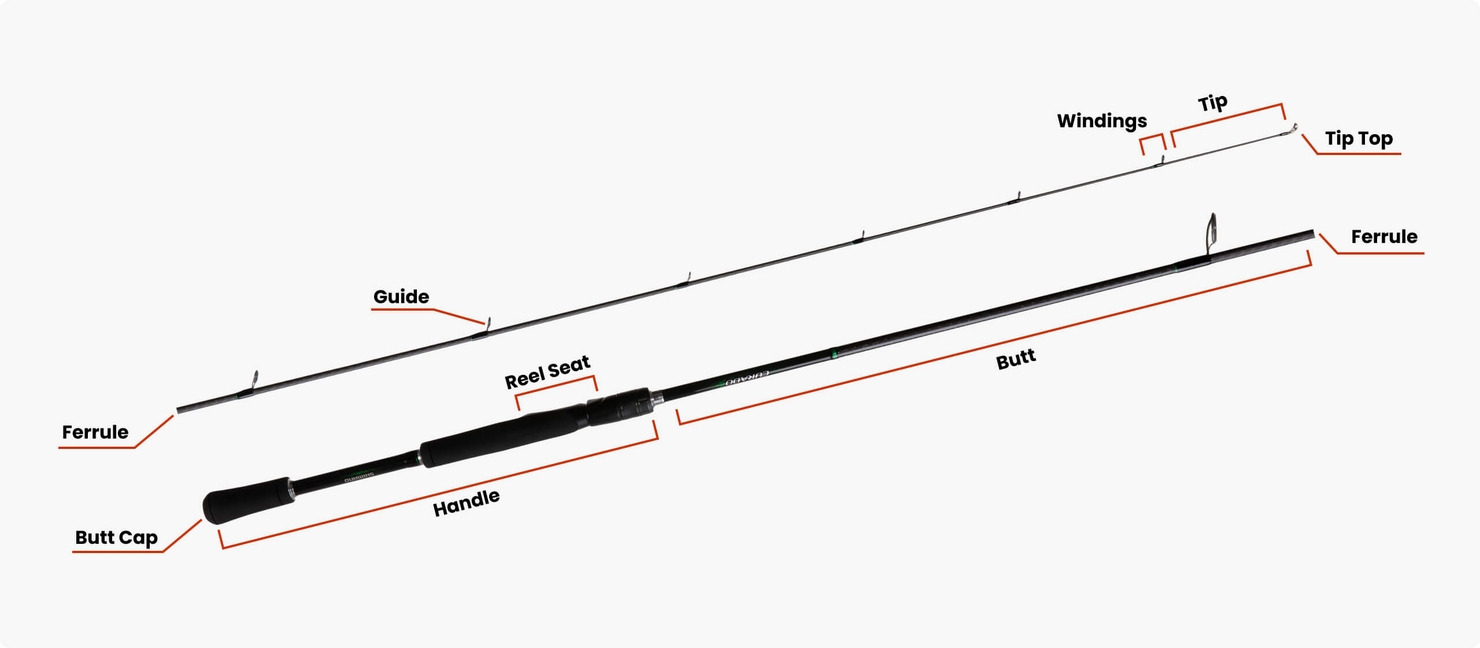
- Tip Top: The metal guide at the farthest part from the handle; the first part of the rod that signals line or lure activity
- Tip: The upper part of the rod which is flexible and prone to curve – can be soft or hard
- Butt: The thickest part of the rod; located close to the handle
- Blank (or shaft): The body of the rod typically made from fiberglass, graphite, or composite materials
- Handle: The part you hold to control your rod; the main area of weight distribution
- Guides: The hollow cylindrical loops along the length of the rod that keep the line close to the rod on the reel and cast
- Windings: These are made of string or other wound material to help secure the guides to the rod; they also reduce any friction the moving line causes
- Ferrules: The area where two separate male or female rod parts meet – only on rods that are more than one piece
- Hook Keeper: The metal ring affixed to the body of the rod allows you to hook your line to the rod when not in use
- Reel Seat: The area where you affix the and where the cast and retrieve happens
- Butt Cap: The closest part to your body; leverages your body for better support when a bigger fish is at the end of your line
Main Fishing Pole Parts
Every fishing pole has a few standard parts (e.g. butt, blank, tip, etc.) that help determine the sensitivity of a rod. The more sensitive a rod is, the better the angler can gauge when a fish bites (or is about to).
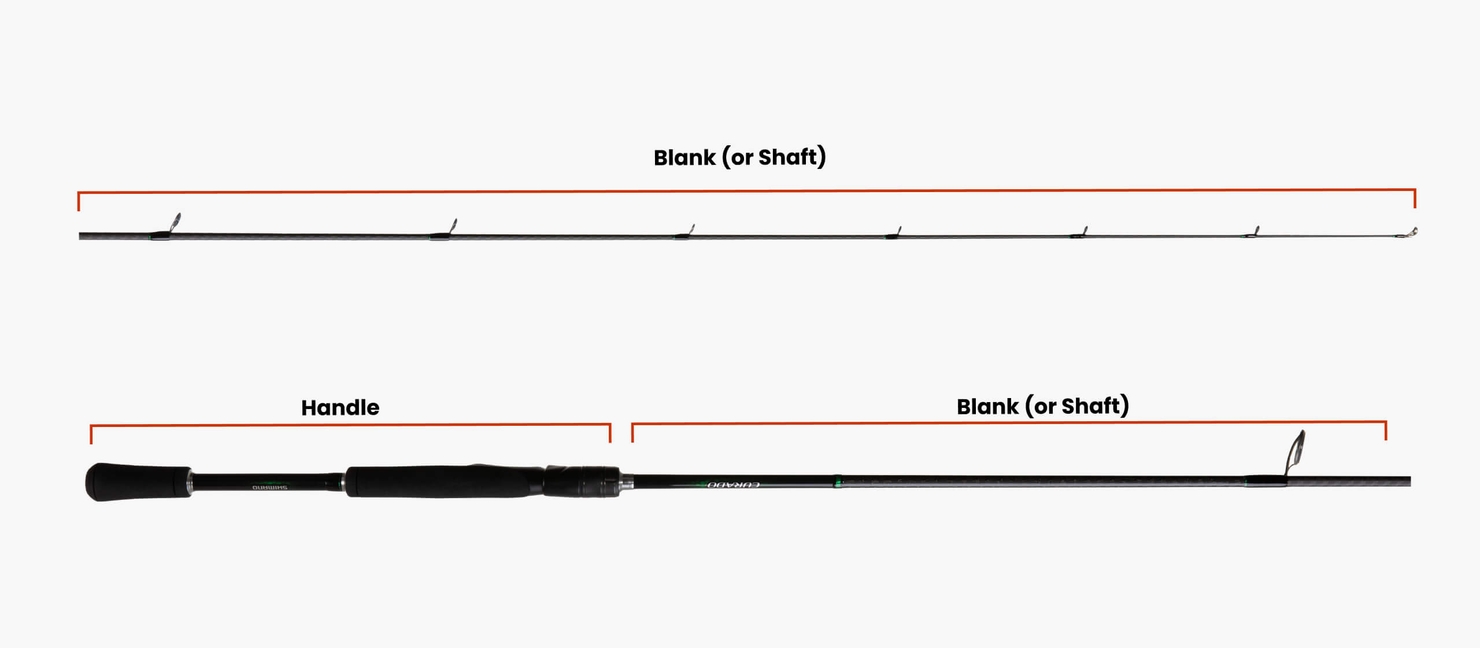
The Blank (or shaft)
The blank (or shaft) is the foundation of the whole rod. It's long and flexible. Blanks draw on materials like fiberglass, graphite, or a hybrid composite for their strength, durability, and reliability. The rod material you choose greatly depends on your fishing style, preference, budget, and preferred fish species:
- Fiberglass: Fiberglass is typically better for fast-action rods. While these rods are traditionally cheaper, they're more durable and great for bait fishing or trolling.
- Graphite: Graphite rods are usually better for high-power rods. They're lightweight and sensitive but are usually pricier.
- Composite: Composite rods can give you improved sensitivity and durability since they are a hybrid of fiberglass and carbon fiber.
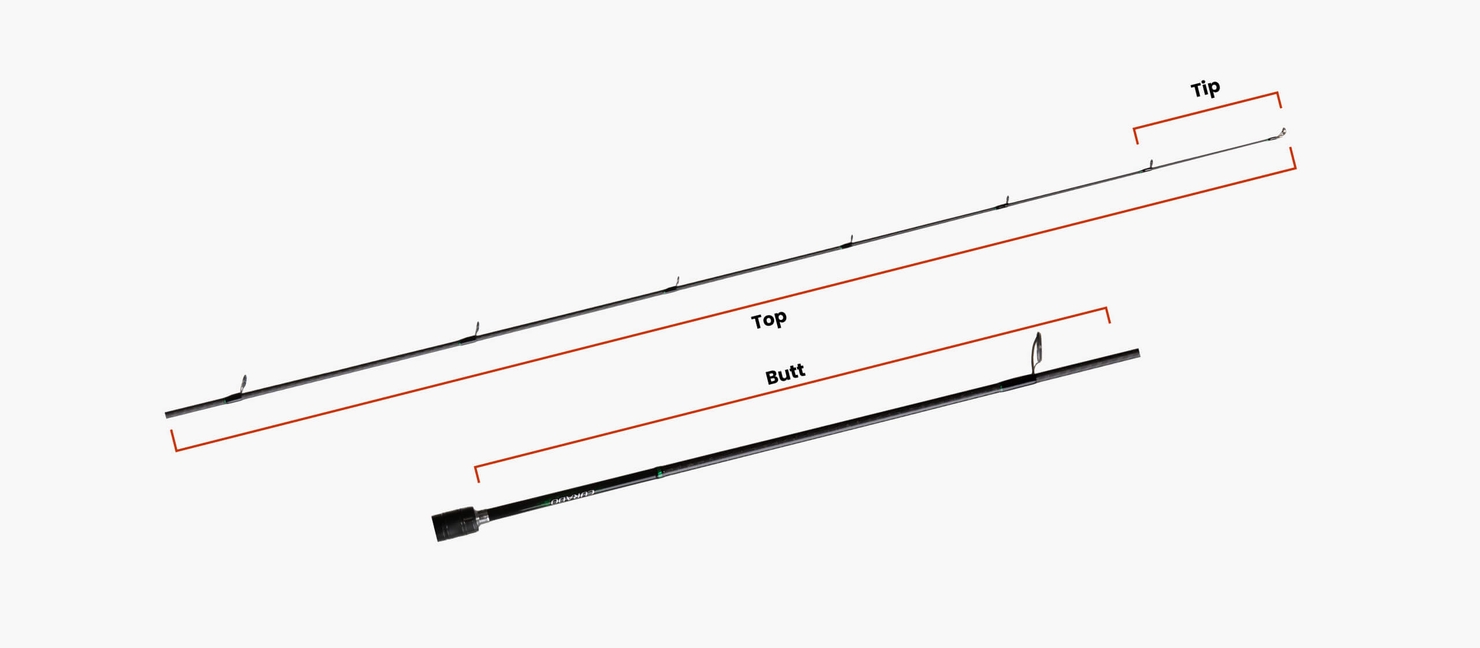
Tip
The tip (not to be confused with the tip top) is the blank's thinnest section that's furthest away from you as you hold and handle the rod. It's sensitive, prone to curve, and helps you gauge when fish are biting. They can be hard or soft in build. Your choice between those options will greatly depend on your unique fishing preferences.
- A hard tip is stronger and less flexible, which is suitable for deep-sea fishing or trolling.
- Soft tips offer more flex and are better for types of fishing when you'll catch lighter fish.
Top
The blank's top refers to the possibly detachable thin section. It can, on most fishing rods, affix to the butt via the ferrules to form one long rod. It's usually a more fragile section that's highly sensitive. When there's too much tension, they can snap. The top's sensitivity indicates any line movements or bites. You'll see it twitch or feel it vibrate when this happens.
Butt
The rod's butt is the thickest part of the blank located near the handle. It's a highly customizable section of the rod. Most rod butts allow you to use rod holders. You'll enjoy less strain since you'll no longer have to handle the rod all day.
Expert Tip:
The butt length differs. The longer it is, the more leverage you will get. Popular types of rod-butt styles include a doorknob butt, a gimbaled butt, or a split grip butt.
The Handle
The lower parts of the rod keep your reel attached to your rod as well as secure and comfortable in your hands. These parts should be durable and high-quality to withstand years of use.
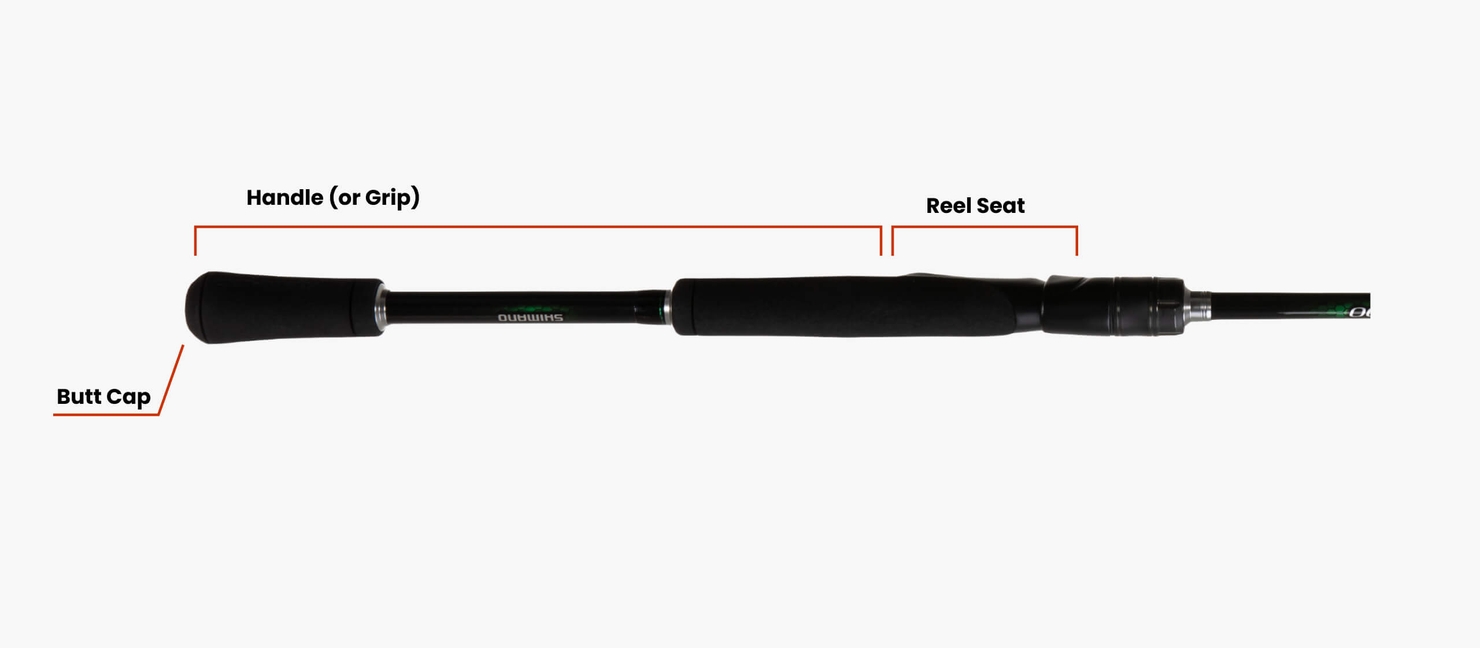
Reel Seat
Without a reel, your rod is a glorified (and pricy) stick! This seat keeps the reel attached to the rod. You'll find many variations of reel seats out there. The most important thing is whether your type of reel actually fits onto your rod's seat.
Butt Cap
Butt caps sit opposite the tip top on your rod. You'll likely have this piece pressed against your body when you reel in those bigger fish. Doing so gives you better leverage. You'll find them made of cork, rubber, or other durable materials. These popular options can preserve your rod over time and prevent corrosion and damage.
Handle (or Grip)
Because you'll grasp the handle (or grip), yours should be comfortable and non-slipping for the best performance. It's here where the weight distributes most evenly. The most dependable handle won't leave you feeling as tired when fishing for long periods of time.
Handles can be made of materials like the following:
- Cork
- Rubber
- EVA foam
- Hybrid composite
Expert Tip:
If you're a beginner angler, look for something padded and thick for added comfort. You'll be able to customize your rod as you go, but comfort is key for all anglers!
Fishing Rod Components
Fishing components keep the rod together and help the line flow smoothly. They often run from the handle to the tip top of the rod. Durability is key so your rod can withstand different fishing conditions.
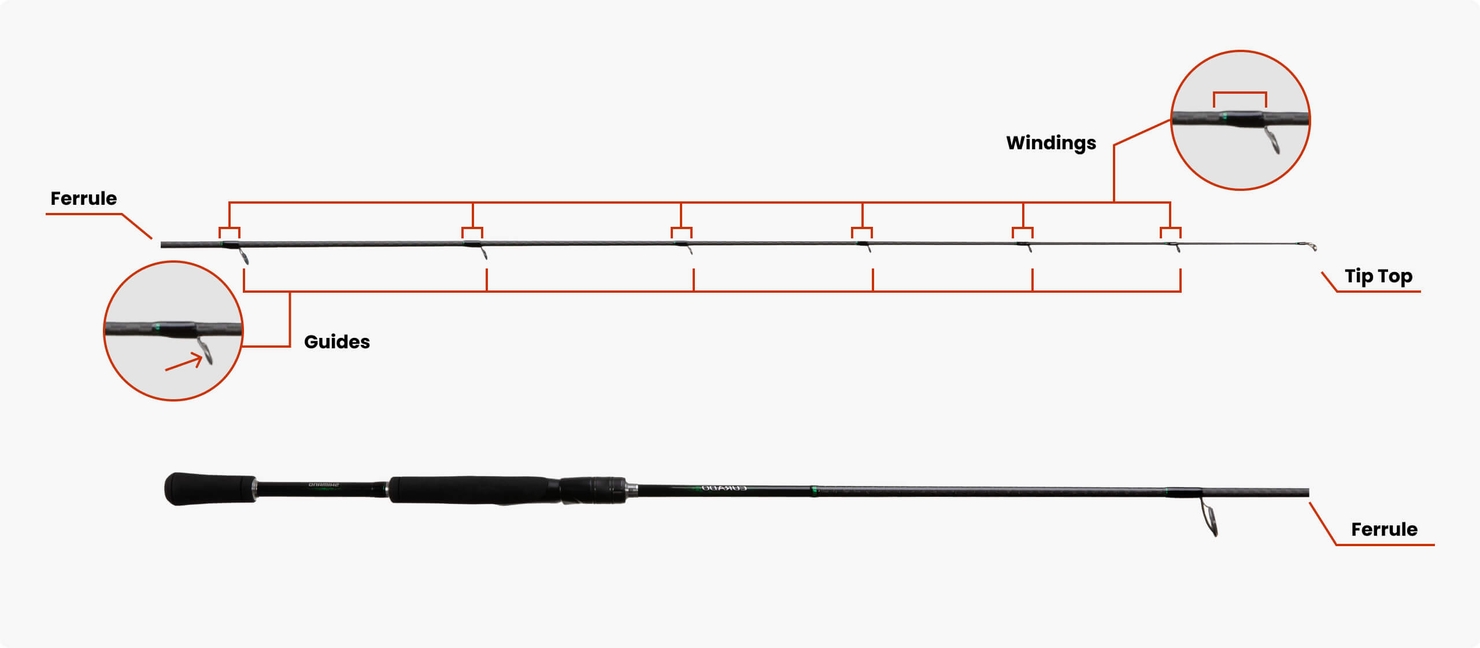
Tip Top
The tip top is the metal guide at the very end of the rod that orients the line into the water. It is a fragile and small component. But it's important for measuring your rod's action.
- The tip top guide is the first part of your rod to signal when any activity happens in the water.
- When a fish bites or shows interest in your bait, it bends to the line's will and weight — twitching and vibrating so you know it's time to retrieve your catch!
Line Guides
Find the line guides (also called eyes) along the length of the rod's blank. They're essential in reducing friction along the line and reducing the potential for knots and tangles.
- They are typically made of metal or graphite.
- The number and spacing can vary across different rods.
Expert Tip:
These guides do play a key role in casting accuracy. That's why baitcasting rods have their guides face up!
Windings
The windings are made of string or similar material that winds around the guides. This keeps them bound to the rod's blank. Glue or another adhesive secures them for good measure! But you likely won't see this since it's usually painted over or covered in another material. The windings dampen the friction as the line moves through the guides and against the rod.
Expert Tip:
The butt length differs. The longer it is, the more leverage you will get. Popular types of rod-butt styles include a doorknob butt, a gimbaled butt, or a split grip butt.
Ferrules
A rod with strong ferrules will stay together better and last longer. All multi-jointed rods have ferrules. They act as a joint where two separate rod pieces need to join together. Some rods may have three pieces. Others may have one long piece without the need for ferrules altogether.
Ferrules join together with male and female pieces:
- Male: Pieces with a special durable extension that secures into the female part.
- Female: Pieces with a recessed cavity that accommodates the extended male piece.
Expert Tip:
Most beginner rods detach in two or more parts. Low-quality ferrules become obvious weak points when made of subpar materials. Invest in rods with strong ferrules, so it doesn't crumble when you cast or retrieve.
Hook Keeper
The hook keeper is a small ring on the rod. It secures the hook when you're not using the rod. Your hook keeper is essential when you transport your rod, switch fishing positions, or simply don't want your hook loose.
Frequently Asked Questions
Q: Do all fishing rods come apart?
No, not all fishing rods come apart. Only rods with multiple pieces actually come apart. Fishing rods can break up into as many as three separate pieces. Choose a rod based on your own fishing preferences. Consider the following:
- The water type (flatwater vs whitewater, freshwater vs saltwater, etc.)
- The species you'll catch (bass, tuna, trout, salmon, etc.)
- The catching strategies and retrieval tactics that you prefer
Q: What is fishing rod action vs power?
- Rod action: The action is the amount of flex a rod has when it's bent. A rod's action ranges from slow (bending the whole length of the rod), medium, and fast (bending only at the tip).
- Rod power: The power is the amount of resistance a rod has to become bent. Power scales from ultra-light (easier to bend) to ultra-heavy (harder to bend).
Q: What's the difference between a fishing rod vs pole?
Semantics — mostly! But, yes. There are a few obvious (and technical) differences between a fishing rod vs a fishing pole. If what you're fishing with has a reel seat, a reel, and line guides, it's actually a rod.
- Fishing rod: Fishing rods give anglers an unrivaled ability to cast, attract, and retrieve a variety of fish species. They give you greater casting distance with the right line and reel. You'll also get the best array of presentation opportunities with lures, baits, jigs, and so much more!
- Fishing pole: Fishing poles have a simple structure without the need for all the various equipment and other gadgets rods require. A pole is simply anything with a line affixed at its tip. No reel — just a more stealthy, precise presentation method in closer range.
Depending on where you grew up, you may say 'pole' as opposed to the more technical name of 'rod'. Some anglers out there might correct you if your pole has guides and a reel. You won't find us correcting you!
Fishing is a deeply personal pastime (you may consider it a sport). What matters is the experience you get out of it. Sure, geography may influence what you call the thing you cast. At the end of the day, it's a trivial difference in language: a fun (or perhaps not so fun) colloquialism among fishers.
Next Steps
Take your fishing rod knowledge and your rod out on your next outing for a successful trip. This all helps you improve your casting and accuracy. Check out our best types of fishing rods guide to help you choose the best one for you.